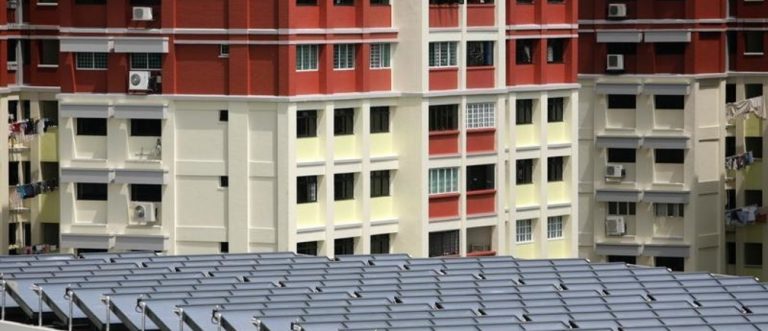Five building blocks for the homes of the future
Sue Riddlestone, co-founder and CEO of the BioRegional Development Group, offers her five building blocks for the homes of the future.
[edit] Introduction
How will we sustain 9 billion people in a resource-constrained world when everyone wants the good life? There just aren’t enough resources to go around – we would need three planets to support this lifestyle for 9 billion of us.
What we have found at BioRegional is that offering something different, such as a home that enables a one-planet lifestyle, it brings a surprising number of other benefits, including better health and quality of life for residents and improved sales, retention and resale.
So how can we build and manage the environmentally friendly homes and neighbourhoods of the future, for rich and poor alike?
I think there are five keys to sustainable homes for 9 billion people:
[edit] Energy saving and renewable generation with local storage and grids
Homes need a lot of energy to keep warm or cool, for lighting, hot water and the ever multiplying gadgets. If we are going to sustain 9 billion people we need net zero carbon homes that are resource efficient in operation and that act as mini power stations.
They could, for example, have building-integrated photovoltaics (PV) and could be supplied by local renewable electricity and heat grids. Energy storage and direct current LED lighting are two ways to make building-integrated PV work well.
This approach is already being developed at the Bicester eco town in Oxford, UK. In Guangzhou, China the 6,000-home Jinshan community draws on traditional methods like high ceilings and shading to reduce the need for air conditioning.
With energy prices rising there is now a huge market for energy retrofitting in existing homes. The Rockefeller Foundation found that in the United States alone, an investment of $279 billion could yield more than $1 trillion of energy savings over 10 years, creating 3.3 million cumulative job years of employment.
All over the world we will need totally decarbonised electricity grids by 2050. The European supergrid is one exciting idea. And in the poorest of homes that have yet to get on the grid, going renewable will reduce the need for expensive energy infrastructure through mini-grids.
[edit] Walkable communities and higher density living
We can’t consider our homes in isolation – what happens when we walk out of the front door? Where are the shops, the schools, the public transport?
In the United States, the financial crisis led to a flight from the suburbs as people couldn’t afford high gas prices for their cars. Now, skinny homes are the new trend in North America, fitting two or more homes in urban areas where one stood before. This is not just an issue for the wealthy, and poorer people are often priced out of the central locations where they work. The latest UN Habitat report highlights the need for access, as opposed to just planning for transport
[edit] Connected living
Technology is transforming our home lives and it can enable sustainable living. Tablets can be used to tell us our energy consumption, the time of the next bus or train, to book a vehicle through a car club or to browse local second-hand items or services.
As we order more of our goods online, our homes are now our shopping centres, to the detriment of the traditional high street and shopping malls. Instead, we are seeing more high street community hubs where people can pick up their Internet deliveries, work locally, buy a coffee and meet their neighbours. Mobile phone technology is similarly transforming the lives of the poorest with mobile banking, health and education services already well established.
[edit] Building less, refurbishing and building smarter
At the London 2012 Olympics, a study found that most of the environmental impact wasn’t people flying in, it was the construction. By opting for lower impact materials, leaner buildings and infrastructure and avoiding wasting materials, London slashed the carbon footprint by 20% and cut costs, too. This sort of approach should be applied across all construction and refurbishment.
[edit] Government strategies and finance for infrastructure and affordable homes for the poorest
For 30 years, governments have increasingly followed a 'leave it to the market' approach to housing. As a result, many poorer people are unable to live in a decent home. Social housing is not only a social good – it is also a good investment. If you build someone a house, they will pay you rent, which will pay back the capital expenditure in time. Better than that, in such a home children will thrive and social problems, which cost society money, are reduced.
With the population of urban areas set to increase, especially in Asia and Africa, it’s important that we build affordable and sustainable homes. All the data shows that sustainable homes and communities are better for people, better for business and essential if we are to sustain a world of 9 billion.
Author: Sue Riddlestone is co-founder and chief executive officer of the BioRegional Development Group. She is a Schwab Foundation Social Entrepreneur.
[Image: Solar thermal collectors are seen against a backdrop of public housing flats on the roof of a building at the United World College of South East Asia (UWCSEA) East Campus in Singapore. REUTERS/Tim Chong]
This article was originally published on the Future of Construction Knowledge Sharing Platform and the WEF Agenda Blog.
--Future of Construction 16:31, 15 Jun 2017 (BST)
[edit] Related articles on Designing Buildings Wiki
Featured articles and news
Ebenezer Howard: inventor of the garden city. Book review.
The Grenfell Tower fire, eight years on
A time to pause and reflect as Dubai tower block fire reported just before anniversary.
Airtightness Topic Guide BSRIA TG 27/2025
Explaining the basics of airtightness, what it is, why it's important, when it's required and how it's carried out.
Construction contract awards hit lowest point of 2025
Plummeting for second consecutive month, intensifying concerns for housing and infrastructure goals.
Understanding Mental Health in the Built Environment 2025
Examining the state of mental health in construction, shedding light on levels of stress, anxiety and depression.
The benefits of engaging with insulation manufacturers
When considering ground floor constructions.
Lighting Industry endorses Blueprint for Electrification
The Lighting Industry Association fully supports the ECA Blueprint as a timely, urgent call to action.
BSRIA Sentinel Clerk of Works Training Case Study
Strengthening expertise to enhance service delivery with integrated cutting-edge industry knowledge.
Impact report from the Supply Chain Sustainability School
Free sustainability skills, training and support delivered to thousands of UK companies to help cut carbon.
The Building Safety Forum at the Installershow 2025
With speakers confirmed for 24 June as part of Building Safety Week.
The UK’s largest air pollution campaign.
Future Homes Standard, now includes solar, but what else?
Will the new standard, due to in the Autumn, go far enough in terms of performance ?
BSRIA Briefing: Cleaner Air, Better tomorrow
A look back at issues relating to inside and outside air quality, discussed during the BSRIA briefing in 2023.
Restoring Abbotsford's hothouse
Bringing the writer Walter Scott's garden to life.
Reflections on the spending review with CIAT.
Retired firefighter cycles world to raise Grenfell funds
Leaving on 14 June 2025 Stephen will raise money for youth and schools through the Grenfell Foundation.
Key points for construction at a glance with industry reactions.
























